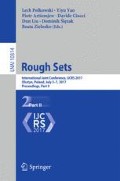Abstract
In this paper, we use an example in evidence-based medicine to illustrate the practical application backgrounds of Pawlak’s rough membership function in real life. By this example, we also point out the limitations of Pawlak’s rough membership function in real life applications and the necessity for constructing rough membership functions for covering-based rough sets. Then, we construct covering-based rough membership function for one type of covering-based rough sets which was examined by Bonikowski et al. (Inf Sci 107:149–167, 1998), and use it to characterize the covering-based rough set approximations numerically. We not only present theoretical backgrounds for this covering-based rough membership function, but also show that this covering-based rough membership function is more realistic than Pawlak’s rough membership function in applications of real life.
Access this chapter
Tax calculation will be finalised at checkout
Purchases are for personal use only
References
Bonikowski, Z., Bryniarski, E., Skardowska, U.W.: Extensions and intentions in the rough set theory. Inf. Sci. 107, 149–167 (1998)
Eells, E., Fitelson, B.: Symmetries and asymmetries in evidential support. Philos. Stud. 107, 129–142 (2002)
Greco, S., Matarazzo, B., Slowinski, R.: Parameterized rough set model using rough membership and Bayesian confirmation measures. Int. J. Approx. Reason. 49, 285–300 (2008)
Intan, R., Mukaidono, M.: Generalization of rough membership function based on \(\alpha \)-coverings of the universe. In: Pal, N.R., Sugeno, M. (eds.) AFSS 2002. LNCS, vol. 2275, pp. 129–136. Springer, Heidelberg (2002). doi:10.1007/3-540-45631-7_18
Lin, G.P., Liang, J.Y., Qian, Y.H.: Multigranulation rough sets: from partition to covering. Inf. Sci. 241, 101–118 (2013)
Ma, L.: On some types of neighborhood-related covering rough sets. Int. J. Approx. Reason. 53, 901–911 (2012)
Miao, D.Q., Li, D.G.: Rough Sets Theory Algorithms and Applications. Tsinghua University Press, Beijing (2008)
Pawlak, Z.: Rough sets. Int. J. Comput. Inform. Sci. 11, 341–356 (1982)
Pawlak, Z.: Some issues on rough sets. In: Peters, J.F., Skowron, A., Grzymała-Busse, J.W., Kostek, B., Świniarski, R.W., Szczuka, M.S. (eds.) Transactions on Rough Sets I. LNCS, vol. 3100, pp. 1–58. Springer, Heidelberg (2004). doi:10.1007/978-3-540-27794-1_1
Pawlak, Z., Skowron, A.: Rough membership functions. In: Yager, R.R., Fedrizzi, M., Kacprzyk, J. (eds.) Advances in the Dempster-Shafer Theory of Evidence, pp. 251–271. Wiley, New York (1994)
Pedrycz, W., Skowron, A., Kreinovich, V.: Handbook of Granular Computing. Wiley, West Sussex (2008)
Pomykala, J.A.: Approximation operations in approximation space. Bull. Polish Acad. Sci. Math. 35, 653–662 (1987)
Samanta, P., Chakraborty, M.K.: On extension of dependency and consistency degrees of two knowledges represented by covering. In: Peters, J.F., Skowron, A., Rybiński, H. (eds.) Transactions on Rough Sets IX. LNCS, vol. 5390, pp. 351–364. Springer, Heidelberg (2008). doi:10.1007/978-3-540-89876-4_19
Shi, Z.H., Gong, Z.T.: The further investigation of covering-based rough sets: uncertainty characterization, similarity measure and generalized models. Inf. Sci. 180, 3745–3763 (2010)
Wong, S.K.M., Ziarko, W.: Comparison of the probabilistic approximate classification and the fuzzy set model. Fuzzy Sets Syst. 21, 357–362 (1987)
Xu, W.H., Zhang, W.X.: Measuring roughness of generalized rough sets induced by a covering. Fuzzy Sets Syst. 158, 2443–2455 (2007)
Yao, Y.Y.: A comparative study of fuzzy sets and rough sets. Inf. Sci. 109, 227–242 (1998)
Yao, Y.Y.: Probabilistic rough set approximations. Int. J. Approx. Reason. 49, 255–271 (2008)
Yao, Y.Y., Zhang, J.P.: Interpreting fuzzy membership functions in the theory of rough sets. In: Ziarko, W., Yao, Y. (eds.) RSCTC 2000. LNCS, vol. 2005, pp. 82–89. Springer, Heidelberg (2001). doi:10.1007/3-540-45554-X_9
Zhang, W.X., Wu, W.Z., Liang, J.Y., Li, D.Y.: Theory and Method of Rough Sets. Science Press, Beijing (2001)
Zhang, W.X., Yao, Y.Y., Liang, Y.: Rough Set and Concept Lattice. Xi’an Jiaotong University Press, Xi’an (2006)
Zhang, Y.L., Li, J.J., Wu, W.Z.: On axiomatic characterizations of three pairs of covering-based approximation operators. Inf. Sci. 180, 274–287 (2010)
Zhang, Y.L., Luo, M.K.: On minimization of axiom sets characterizing covering-based approximation operators. Inf. Sci. 181, 3032–3042 (2011)
Zhu, P.: Covering rough sets based on neighborhoods: an approach without using neighborhoods. Int. J. Approx. Reason. 52, 461–472 (2011)
Zhu, W.: Topological approaches to covering rough sets. Inf. Sci. 177, 1499–1508 (2007)
Zhu, W., Wang, F.Y.: On three types of covering-based rough sets. IEEE Trans. Knowl. Data Eng. 19, 1131–1143 (2007)
Zhu, W., Wang, F.Y.: The fourth type of covering-based rough sets. Inf. Sci. 201, 80–92 (2012)
Acknowledgment
This work is supported by the National Natural Science Foundation of China (nos. 11301367, 11501404, 61440047, 61562079), Jiangsu Province Natural Science Foundation (no. BK20140583), Natural Science Foundation of Guangxi (no. 2014GXNSFBA118015), Key Laboratory Program of Guangxi University (no. 2016CSOBDP0004), and the Priority Academic Program Development of Jiangsu Higher Education Institutions.
Author information
Authors and Affiliations
Corresponding author
Editor information
Editors and Affiliations
Rights and permissions
Copyright information
© 2017 Springer International Publishing AG
About this paper
Cite this paper
Ge, X., Tang, J., Wang, P. (2017). The Rough Membership Function on One Type of Covering-Based Rough Sets and Its Applications. In: Polkowski, L., et al. Rough Sets. IJCRS 2017. Lecture Notes in Computer Science(), vol 10314. Springer, Cham. https://doi.org/10.1007/978-3-319-60840-2_4
Download citation
DOI: https://doi.org/10.1007/978-3-319-60840-2_4
Published:
Publisher Name: Springer, Cham
Print ISBN: 978-3-319-60839-6
Online ISBN: 978-3-319-60840-2
eBook Packages: Computer ScienceComputer Science (R0)

